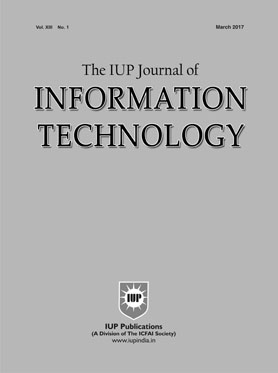
Sep' 22
The IUP Journal of Information Technology
Focus
Neural Network (NN) is an ML algorithm that simulates the behavior of human brain to learn from the data and perform classification and prediction tasks in various decision areas. Deep Learning, which essentially uses an NN with several hidden layers, improves the performance of classification and prediction tasks with a higher level of accuracy. Deep learning algorithms are normally complex with massive computations, which forms the basis for higher accuracy. Algorithms such as Convolutional Neural Network (CNN) and Recurrent Neural Network (RNN) are very efficient in pattern recognition tasks. In particular, the performance of CNN in image processing and recognition applications touches human-level of accuracy. Similarly, RNN is very good at natural language processing and speech recognition applications.
The first paper, "Classification of Product Backlog Items in Agile Software Development: A Deep Learning-Based Approach" by Kuhaneswaran Banujan and Nirubikaa Ravikumar, presents a Deep Learning method to classify Product Backlog Items (PBIs). Classification of PBIs is an essential task before Sprinting in Agile Software Development. Using a dataset that includes PBIs considered from several software projects, the authors have found that the Deep Learning algorithm Long Short-Term Memory (LSTM) outperforms the conventional ML algorithm Artificial Neural Network (ANN) with an accuracy of 92.4%.
The second paper, "An Ensemble Learning Approach to Classifying Documents Based on Formal and Informal Writing Styles" by K M G S Karunarathna, R A H M Rupasingha and B T G S Kumara, proposes an ensemble method for document classification according to its style. The authors have considered five classification algorithms: Random Forest, Naive Bayes, SVM, Decision Tree and MLP. The ensemble learning algorithm that combines these five algorithms using majority voting outperforms the accuracy of any of the individual algorithms with 91.96% accuracy.
The last paper, "Influence of Social Media on College Students' Online Shopping Behavior: A Study in Arunachal Pradesh, India" by Chanda Wakhet and Tasi Kaye, concludes, based on its findings, that students use social media mostly for entertainment and relaxation purposes.
Consulting Editor
|
|
|||
| Article | Price (₹) | ||
| Classification of Product Backlog Items in Agile Software Development: A Deep Learning-Based Approach |
100
|
||
| An Ensemble Learning Approach to Classifying Documents Based on Formal and Informal Writing Styles |
100
|
||
| Influence of Social Media on College Students' Online Shopping Behavior: A Study in Arunachal Pradesh, India |
100
|
||
Classification of Product Backlog Items in Agile Software Development: A Deep Learning-Based Approach
Agile Software Development (ASD) is an iterative method of project management and software development that enables teams to provide customer value more quickly with fewer complications. Product Backlog Items (PBI) are a prioritized list to-be-implemented ASD requirements. Prior to beginning sprinting in the ASD, one of the most crucial duties is the classification of PBI. Using Machine Learning and Deep Learning methods, the authors sought to categorize the PBI into Spikes, Foundational stories and User stories. They initially gathered data from numerous software development initiatives and web sources. Each PBI was classified manually as Spikes, Foundational stories, or User stories and preprocessed to remove superfluous text content. Using the TF-IDF and GloVe techniques, the preprocessed PBI were then embedded with words. ANN and LSTM were used to classify the PBIs. The paper models combinations of TF-IDF+ANN, GloVe+ANN and GloVe+LSTM. With an accuracy of 92.4%, the GloVe+LSTM model surpassed other deployed models.
An Ensemble Learning Approach to Classifying Documents Based on Formal and Informal Writing Styles
With recent advances in technology, many students and scholars have been tempted to use the Internet as their main educational resource since they can obtain a variety of documents online. These documents can be classified as either formal or informal in writing style, involving different linguistics. The paper presents a method to identify automatically the style of a particular document. First, a dataset of online documents was compiled and preprocessed. Next, features were extracted via a Term Frequency-Inverse Document Frequency vectorizer. Classification models were then built using six classification algorithms. Initially, five Machine Learning algorithms-Random Forest, Decision Tree, Support Vector Machine, Multilayer Perception, and Naive Bayes-were used. Of these five algorithms, the Random Forest algorithm performed best, obtaining an accuracy of 87.44%, high values for precision and recall, and an F-measure with the lowest error rate. In the second experiment, an Ensemble Learning method was used, whereby a Vote algorithm was used with a combination of the five algorithms. This method obtained an accuracy of 91.96%. The method combines several algorithms.
Influence of Social Media on College Students' Online Shopping Behavior: A Study in Arunachal Pradesh, India
The Information Technology (IT) sector has changed tremendously, as evidenced by the advancement of interactive tools, applications and software. Social media is one of the contemporary communication tools which provides a platform where people can socialize and share their thoughts through text and multimedia messages. This study aims at exploring the impact of social media on college students' online shopping behavior in Arunachal Pradesh, India. It also seeks to find out if there is any relationship between social media use and students' online shopping behavior. The data for the study was obtained from 372 college students through a well-structured self-designed questionnaire. The study concludes that there is a relationship between social media use and students' online shopping behavior. Further, students use social media mostly for entertainment and relaxation purposes.